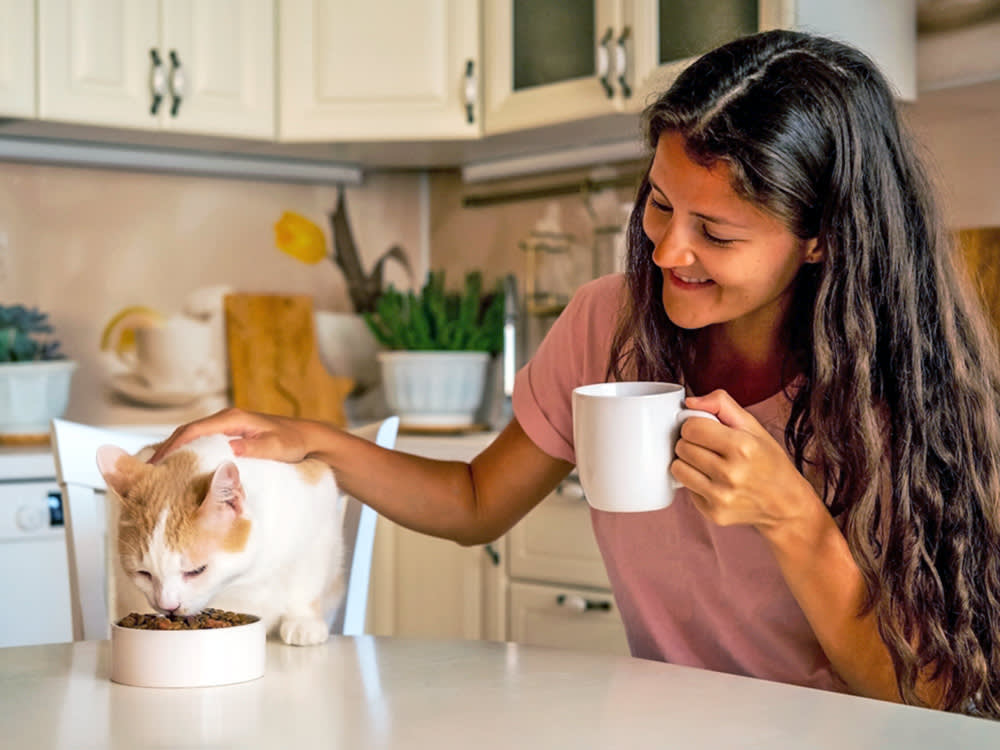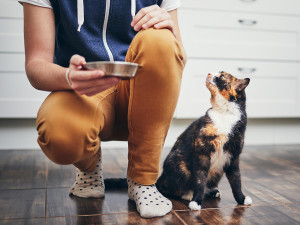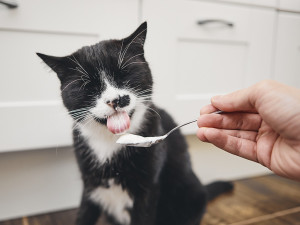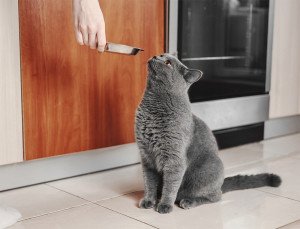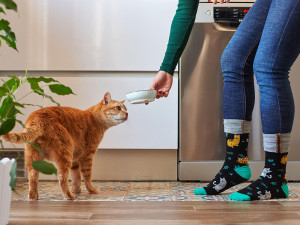6 Easy Ways to Add Fiber to Your Cat’s Diet
Do cats need fiber? Of course, they do. Here’s how to make sure your kitty is getting enough.
In This Article:
Do Cats Need Fiber? How Much Fiber Do Cats Need? Types of Fiber Signs Your Cat Needs More Fiber How to Add Fiber to Your Cat’s Diet 6 Natural Sources of Fiber What if Your Cat Won’t Eat Natural High-Fiber Foods Potential Side Effects of Increased Fiber
Fiber is a hot topic in any nutritional circle. It does a lot of things for the body and even a little bit for the mind, by keeping digestion regular and helping you to feel full. The good news is that fiber is good for your cat, too — not only to make sure their litter box gets a regular visit, but also to help keep them feeling full, playing a part in managing a healthy weight.
But because cats are obligate carnivores, adding fiber to their diet can get a little tricky. Fortunately, we’ve got you covered with these six easy ways to help your kitty feast on fiber.
How much do you spend on your pet per year?
Do cats need fiber in their diet?
When talking about feline nutrition, it seems to be all about the protein. Yes, cats are obligate carnivores, which means they thrive on high amounts of animal proteins in their diet, but meat isn’t the only thing they need. Looking at any commercial cat food label will show you that things such as whole grains, fruits, and vegetables are also added in there to provide your kitty with vitamins, minerals, and carbohydrates — some of which come in the form of fiber.
Benefits of fiber for cats
Fiber is needed to bulk up bowel movements and stimulate defecation to help your cat stay regular, helping to prevent both diarrhea and constipation. It also helps your kitty feel full for longer, so they’re not constantly begging for food. And it’s an energy source for their all-important gut bacteria, which helps with digestion and immune function.
How much fiber do cats need?
We’re going to go back to that obligate carnivore classification: Cats need a lot of protein, not only for muscle building and maintenance, but for energy as well. Because of this, they require fewer carbohydrates than humans or other animals. So, don’t expect your cat’s dietary fiber needs to be high.
For most healthy, active adults, this means less than 5 percent of their diet can be fiber. For cats who need to lose a few pounds, are fairly inactive, or have certain health issues, fiber content can reach up to 15 percent. Your vet will be the best judge of how much fiber is right for your cat, so be sure to include them in the conversation.
Types of fiber for cats
Fiber comes in two forms: soluble and insoluble. Your cat’s system will do best on a combination of the two.
Soluble fiber dissolves in water. It plays an important role in treating diarrhea and helping keep your cat’s tummy from rumbling between meals.
Insoluble fiber is the opposite. It moves through the digestive tract fairly unchanged. Because of this, it bulks up bowel movements and helps stimulate intestinal movement, making it great at treating constipation and hairballs.
Signs your cat needs more fiber
Does your kitty need a fibrous boost? Most healthy cats do well with the amount of fiber in their commercial diet, but if your cat is experiencing some chronic digestive issues, they may need a bit more. Look for signs such as:
Diarrhea
Constipation
Frequent hairballs
Cats who need to lose a few pounds may benefit from a higher fiber diet as well.
How to add fiber to your cat’s diet
First, start by checking the fiber content of your current cat food, and look for a diet that’s a little higher. Most quality cat food companies make higher-fiber diets to aid cats with chronic digestive issues or weight loss. Choosing the right cat food can be complicated, so speak to your veterinarian.
If that’s not an option, look to add fiber through a more creative avenue.
6 natural sources of fiber for cats
The following may be great sources of fiber, but they should still be fed in moderation. It’s important to remember that these aren’t the only foods that can be beneficial, and that not all human foods are safe for your kitty.
1. Canned pumpkin
Believe it or not, most cats love the stuff. Just make sure it’s plain pumpkin, not pumpkin pie filling, which is filled with potentially harmful additives.
2. Green beans
Raw, frozen, or canned — aim for a plain, unseasoned version.
3. Carrots
Same as green beans, carrots need to be plain and cut into bite-sized pieces to prevent choking.
4. Apples
Cats can’t actually taste sweetness, but that doesn’t mean they won’t like apples or even raspberries. Remove the core and stem, and cut into bite-sized pieces.
5. Broccoli
Fortunately, most cats don’t have the broccoli stigma that a lot of humans develop as children and will eat it raw or cooked.
6. Spinach
Some kitties really like leafy greens, including spinach. You can even add a little color with a few ripe tomatoes.
What if your cat won’t eat natural high-fiber foods
Though the above list may look good on paper, it may not be appetizing in your cat’s food bowl. So, what’s a cat parent to do? Fortunately, there are many fiber supplements available for cats that can do the trick.
Types of fiber supplements for cats
We talked a little bit about high-fiber diets, so that’s always a good place to start. Otherwise, look for fiber supplements that may come in the form of powders, tablets, food toppers, or treats. Most of these are given daily with or without food.
Homemade high-fiber treats for cats
If you like to cook, making your own high-fiber cat treatsopens in new tab may be the way to go. Recipes may contain whole grains, pumpkin, and other ingredients to boost the fiber intake.
Potential side effects of increased fiber intake in cats
Fiber is a good thing to have in your cat’s diet, but it is possible to overdo it. Let’s look at the paradox of how fiber can help with both diarrhea and constipation.
The type of fiber determines the benefit that it will have. So, it makes sense that providing an excess of that type of fiber would have the reverse effect. For example, soluble fiber helps treat diarrhea by slowing down digestion and gelling the consistency of the feces. Too much could not only clear up diarrhea, but actually cause constipation.
Before adding fiber to your cat’s diet, check in with your veterinarian to determine what type and how much you should give them.
Bottom line
Fiber is an important component of a complete and balanced feline diet. Increasing it may be beneficial for cats who have chronic digestive issues or who need to lose weight.
Treating your kitty to some natural high-fiber foods such as green beans, carrots, and pumpkin (in moderation) is a great way to increase their fiber intake.
Speak to your veterinarian before giving your cat any additional foods or supplements.
FAQs
Will fiber help my cat’s diarrhea?
Adding soluble fiber to your cat’s diet can help ease diarrhea by slowing down the digestive process, which can allow for increased water absorption from the feces and thicken up bowel movements.
What is the best source of fiber for cats?
There’s no one best source of fiber, but adding some fruits and vegetables to their diet (see above) is a great place to start. Otherwise, look into a fiber supplement or treat, both of which can increase their fiber intake.
Do indoor cats need more fiber?
Indoor cats tend to be less active than their outdoor counterparts, so a higher fiber intake may help prevent weight gain by adding bulk with fewer calories.
How to tell if your cat needs more fiber
Cats with chronic digestive issues such as diarrhea, constipation, or frequent hairballs may benefit from more fiber. Cats who need to lose weight may also appreciate it.
References
Linder, Deborah, DVM. “Featuring Fiber: Understanding Types of Fiber and Clinical Uses.” Today’s Veterinary Practice. Jan/Feb 2017. https://todaysveterinarypractice.com/nutrition/understanding-types-fiber-clinical-usesopens in new tab.
Moreno, Adam A, Valerie J Parker, Jenessa A Winston, and Adam J Rudinsky. “Dietary fiber aids in the management of canine and feline gastrointestinal disease.” JAVMA. 26 Oct 2022. https://pubmed.ncbi.nlm.nih.gov/36288203opens in new tab.
“4 Recipes for Homemade Cat Treats.” Oakland Veterinary Referral Services. 17 Jul 2024. https://www.ovrs.com/blog/4-recipes-for-healthy-homemade-cat-treatsopens in new tab.
